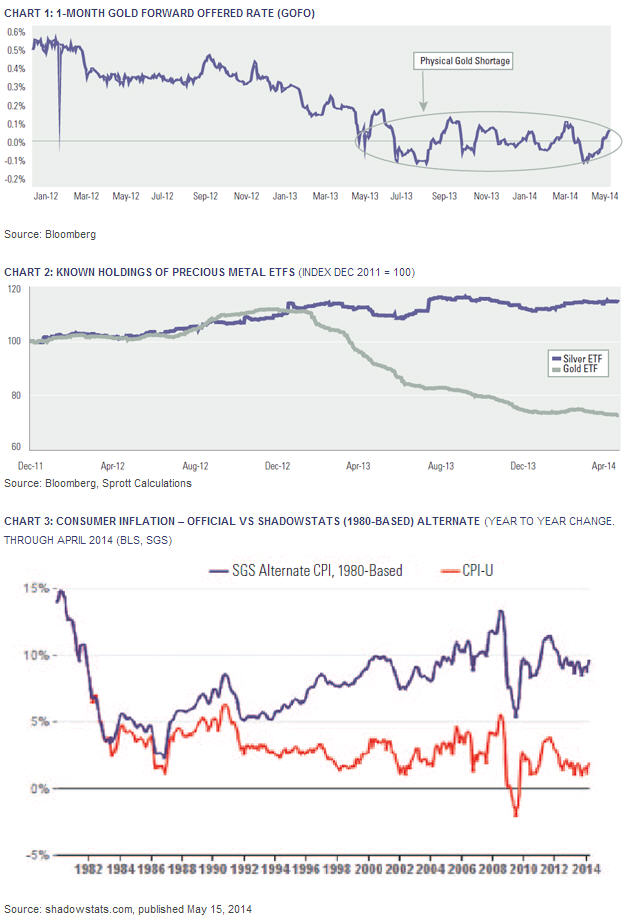Connecting the dots
In this month’s Markets at a Glance, we present a collection of thoughts on why we think precious metals are a compelling investment now.
On physical demand and the shortage of precious metals:
- The Gold Forward Offered Rate (GOFO) remains very low, with extended periods of time in negative territory (Chart 1).1
- Why is Germany’s repatriation of their 674 tonnes of gold taking so long? As of March 2014, only 69 tonnes had made their way back, a pace of less than 5 tonnes a month.2
- If there is no shortage of gold, why are the U.S. and U.K. exporting so much gold to Switzerland? (which itself exports most of it to China).3
- According to some estimates, China consumed over 4,800 tonnes of gold in 2013, implying that about 3,600 tonnes were drawn from global stocks (i.e. western vaults) to satisfy demand.4
- All this Chinese buying is reflected in the monstrous amounts of gold deliveries on the Shanghai Gold Exchange.
- Dubai is building a new gold refinery capable of handling 1,400 tonnes, and current global gold refining capacity is about 6,000 tonnes (world mine production is less than 3,000 tonnes a year).5 Why would they need so much refining capacity if physical demand was not buoyant?
- As the major gold miners cut back on exploration, future mine supply will remain constrained.
- Another “temporary source of supply” (900 tonnes) has been ETFs, which have been raided for most of 2013. However, as Chart 2 shows, they have now stabilized. Other things being equal in demand, where will that 900 tonnes of supply come from in 2014?
- Interestingly, the Silver Institute, in its 2014 World Silver Survey, noted that there was a 96 million ounces shortfall in 2013 due to strong physical demand.
On the macroeconomic environment:
- The real level of inflation is high and much higher than official figures (Chart 3). Precious metals have historically hedged against inflation.
- Speaking of inflation, the large amount of money printing and the bloating of U.S. Central Bank’s balance sheet will most likely end badly.
- According to Jürgen Stark, former European Central Bank board member, central banks have lost all ability to control the economic situation. In other words, we live in a fictional sense of security.7
- Vladimir Putin thinks that “China and Russia need to ensure their gold and other currency reserves are secure”.8 At the same time, the Russian Central Bank continues to be a large buyer of gold and a seller of U.S. Treasuries.9,10
On manipulation:
- The CME Group might introduce daily limits on gold and silver price moves to limit the extreme volatility we have seen in recent years (i.e. to prevent, going forward, any large spikes up in price).11
- Investigations into the gold fixing mechanism by the German financial regulator BaFin and the subsequent withdrawal of Deutsche Bank from the gold fixing suggest something is wrong.
- More recently, Barclays got fined 26 million pounds because one of its traders manipulated the gold fix to avoid paying on a gold derivative.12
- Some market participants are suing the banks responsible for the gold fix over alleged manipulation.13
- The company that ran the Silver fix “suddenly” decided to stop running the process.14
- As argued in the January 2014 Markets at a Glance, we find it strange that in 2013, gold ETFs were raided, whereas silver, which experienced the same price declines, stayed in the ETF’s vaults (Chart 2).15 This suggests that the ETF’s gold was needed to satisfy physical demand.
To conclude, we believe that any rational investor considering this collection of facts would consider, like us, that gold prices are long overdue for a re-rate. As we all well know, almost all markets are manipulated; and the recent Barclays settlement is one example vindicating our views (more to come?).
» The global macro environment is weak,
» Supply/demand numbers in our favour,
» Ponzi finance is in full bloom.
We encourage readers to protect themselves with any/all precious metals.
By Eric Sprott
{{ commodity.name }}
{{ post.title }}
{{ post.date }}


Comments